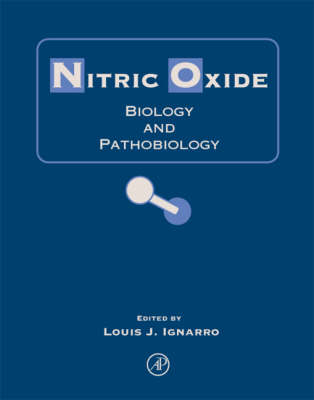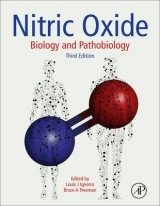
Nitric Oxide
Academic Press Inc (Verlag)
978-0-12-370420-7 (ISBN)
- Titel erscheint in neuer Auflage
- Artikel merken
Nitric oxide (NO) is a gas that transmits signals in an organism. Signal transmission by a gas that is produced by one cell and which penetrates through membranes and regulates the function of another cell represents an entirely new principle for signaling in biological systems.
NO is a signal molecule of key importance for the cardiovascular system acting as a regulator of blood pressure and as a gatekeeper of blood flow to different organs. NO also exerts a series of other functions, such as acting a signal molecule in the nervous system and as a weapon against infections. NO is present in most living creatures and made by many different types of cells.
NO research has led to new treatments for treating heart as well as lung diseases, shock, and impotence. Scientists are currently testing whether NO can be used to stop the growth of cancerous tumors, since the gas can induce programmed cell death, apoptosis.
This book is the first comprehensive text on nitric oxide to cover all aspects--basic biology, chemistry, pathobiology, effects on various disease states, and therapeutic implications.
Louis J. Ignarro, PhD, is Distinguished Professor Emeritus of the Department of Molecular and Medical Pharmacology at the UCLA School of Medicine. He has broad and extensive experience in the molecular and chemical biology of the nitric oxide-cyclic GMP signaling systems. He and his basic research teams have discovered and expanded the production and actions of nitric oxide in mammalian tissues, including the protective roles of nitric oxide in preventing hypertension, stroke and myocardial infarction, and its neurotransmitter role as the mediator of erectile function in humans. For these discoveries, he was awarded the Nobel Prize in Physiology or Medicine.
Contributors
Preface
Section I Overview of Basic Principles
Chapter 1 Introduction and Overview
Section II Principles of Biology
A. Chemical Biology
Chapter 2 The Chemical Properties of Nitric Oxide and Related Nitrogen Oxides
Chapter 3 The Chemical Biology of Nitric Oxide
Chapter 4 The Biological Chemistry of Peroxynitrite
Chapter 5 A Comparison of the Biological Reactivity of Nitric Oxide and Peroxynitrite
B. Nitric Oxide Synthases
Chapter 6 Structural Variations to Accommodate Functional Themes of the Isoforms of NO Synthases
Chapter 7 Regulation of the Expression of Nitric Oxide Synthase Isoforms
Chapter 8 Molecular Regulation of Inducible Nitric Oxide Synthase
Chapter 9 Molecular Control of Endothelial Derived Nitric Oxide: A New Paradigm for Endothelial NOS Regulation by Posttranslational Modification
C. Regulation of Nitric Oxide Production
Chapter 10 Tetrahydrobiopterin: An Essential Cofactor of Nitric Oxide Synthase with an Elusive Role
Chapter 11 Regulation of Arginine Availability and Its Impact on NO Synthesis
Chapter 12 Relationship between Arginase Activity and Nitric Oxide Production
D. Transport, Membrane Interactions, and Oxygen Transport
Chapter 13 The Physical Properties of Nitric Oxide: Determinants of the Dynamics of NO in Tissue
Chapter 14 Membrane Transport of Arginine and Cationic Amino Acid Analogs
Chapter 15 The Respiratory Cycle: A Three-Gas System
E. Nitric Oxide and Oxidative Stress
Chapter 16 Role for Nitric Oxide and Other Radicals in Signal Transduction
Chapter 17 Antioxidant Actions of Nitric Oxide
Chapter 18 Mechanisms through Which Reactive Nitrogen and Oxygen Species Interact with Physiological Signaling Systems
Chapter 19 Nitric Oxide, Oxygen Radicals, and Iron Metabolism
Chapter 20 Redox Modulation of Iron Regulatory Proteins by Nitric Oxide and Peroxynitrite
Chapter 21 Nitric Oxide, Oxidative Stress, and Signal Transduction
Chapter 22 Mechanisms of Antioxidant Defense against Nitric Oxide/Peroxynitrite
Chapter 23 Regulation of Oxygen Metabolism by Nitric Oxide
F. Signal Transduction Mechanisms
Chapter 24 Structure–Function Relationships in NO-Sensitive Guanylyl Cyclase
Chapter 25 Mechanism of Activation of Soluble Guanylyl Cyclase by NO: Allosteric Regulation through Changes in Heme Coordination Geometry
Chapter 26 Cyclic GMP-Mediated Signaling Mechanisms in Smooth Muscle
Section III Principles of Pathobiology
A. NO and the Nervous System
Chapter 27 Influence of Nitric Oxide on Neuroendocrine Function and Behavior
Chapter 28 Nitric Oxide and Cerebral Ischemia
Chapter 29 Role of Nitric Oxide in Neuronal Protection versus Apoptosis
Chapter 30 Nitric Oxide and Autoimmune Disease in the Nervous System: Pathobiology of Inflammation and Demyelination
B. NO and Cardiovascular Function
Chapter 31 Role of Nitric Oxide in the Regulation of Blood Flow
Chapter 32 Nitric Oxide Synthase Gene Transfer
Chapter 33 Functional Influence of Gene Transfer of Recombinant Nitric Oxide Synthase to Cardiovascular System
Chapter 34 Nitric Oxide and Vascular Endothelial Dysfunction
Chapter 35 Endothelium-Derived Hyperpolarizing Factor and Its Interaction with NO
Chapter 36 Role of Nitric Oxide in Myocardial Function
Chapter 37 Role of Nitric Oxide in the Microcirculation
Chapter 38 Activation of NOS by Ca2+-Dependent and Ca2+-Independent Mechanisms
C. Pathophysiological Mechanisms of Nitric Oxide
Chapter 39 Role of Nitric Oxide in Ischemia–Reperfusion Injury
Chapter 40 Nitric Oxide: A Critical Determinant in Ischemia–Reperfusion
Chapter 41 Role of Nitric Oxide in Myocardial Ischemia–Reperfusion Injury
Chapter 42 Use of Mutant Mice to Elucidate Neuroprotective and Neurotoxic Actions of Nitric Oxide in Cerebral Ischemia
Chapter 43 Neurotoxic Actions and Mechanisms of Nitric Oxide
Chapter 44 Role of Macrophage-Derived Nitric Oxide in Target Cell Injury
Chapter 45 Physiological and Pathophysiological Roles of Nitric Oxide in Gastrointestinal Function
Chapter 46 Pathophysiological Effects of High-Output Production of Nitric Oxide
Chapter 47 Nitric Oxide and Septic Shock
Chapter 48 Nitric Oxide and Vascular Disease
Chapter 49 Cytotoxic Role of Nitric Oxide in Diabetes
Chapter 50 Role of Inducible Nitric Oxide Synthase in Autoimmune or Other Immune-Mediated Diseases
Chapter 51 Nitric Oxide and Platelet Function
Chapter 52 Pathophysiological Roles of Nitric Oxide in Inflammation
Chapter 53 Nitric Oxide, Chronic Joint Inflammation, and Pain
Chapter 54 Nitric Oxide and Cancer
D. Clinical Significance of Nitric Oxide
Chapter 55 Vascular Nitric Oxide in Health and Disease
Chapter 56 Clinical Therapy with Inhaled Nitric Oxide in Respiratory Diseases
Chapter 57 Airborne Nitric Oxide in Health and Disease
Chapter 58 Nitric Oxide and Persistent Pulmonary Hypertension in the Newborn
Index
| Erscheint lt. Verlag | 13.9.2000 |
|---|---|
| Verlagsort | San Diego |
| Sprache | englisch |
| Maße | 216 x 279 mm |
| Gewicht | 2670 g |
| Themenwelt | Medizin / Pharmazie ► Medizinische Fachgebiete ► Pharmakologie / Pharmakotherapie |
| Naturwissenschaften ► Biologie ► Biochemie | |
| Naturwissenschaften ► Biologie ► Genetik / Molekularbiologie | |
| Naturwissenschaften ► Biologie ► Zellbiologie | |
| ISBN-10 | 0-12-370420-0 / 0123704200 |
| ISBN-13 | 978-0-12-370420-7 / 9780123704207 |
| Zustand | Neuware |
| Haben Sie eine Frage zum Produkt? |
aus dem Bereich



